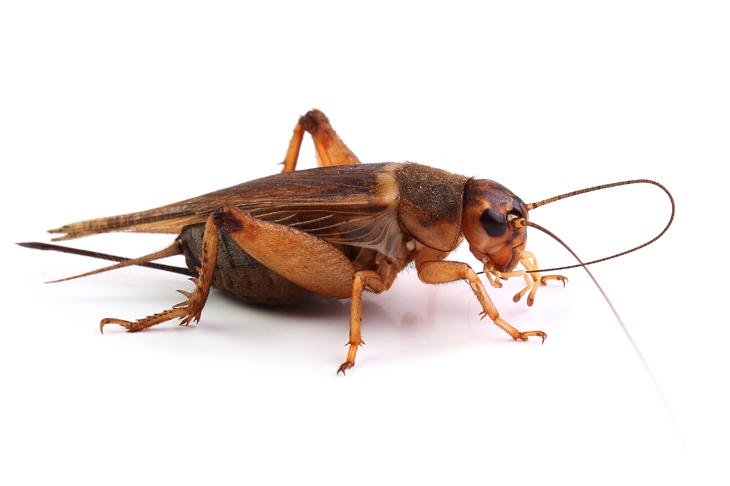After school last Wednesday, I watched my five-year-old daughter pop a dead cricket on to her tongue and proclaim it: ‘Like fishy popcorn!’ ‘MMMm, delicious!’ squealed her friend, reaching for more as a third little girl spat hers, discreetly, back into her palm. ‘I’m getting pistachio,’ said the spitter’s mum, picking up the packet for closer scrutiny. I popped one into my own mouth and got stale, mealy, chewy: like a morsel of dusty, old crab-paste sandwich.
I bought the edible Acheta domesticus at my local farm shop. They were stacked, like a drinking bet, above the local gins under a sign reading: ‘Sharing for the Daring.’ Mealworms with Sesame and Cumin; Grasshoppers with Paprika and Crickets with Sweet Mango. Pretty pricey at £6.50 for 14g. Suburban Essex’s answer to TV’s Bush-tucker Trials and tabloid splashes about Angelina Jolie frying scorpions with her kids.
More seriously, entomophagy (eating insects) is often pitched to us as the sustainable protein source of the future. If the human population reaches the estimated nine billion by 2050, our current environment trashing rates and methods of meat production won’t keep up. Compared to beef and pork, insects are also a healthy choice: low in fat and high in calcium.
But the myth of bugs as ‘the new food Messiah’ is briskly scotched in the opening pages of Phaidon’s beautiful new book On Eating Insects. Mark Bomford, Director of the Yale Sustainable Food Project, says the problems we face as ‘a moderately successful social animal with a poor feed-conversion ratio’ are far too complex to be solved so easily. Although entomophagy would cause far less environmental damage than cattle farming, he thinks we can do better. He goes on to make the surprising claim that we’d be more humane, take far fewer lives and cause much less environmental damage if we could find a sensible way to eat large whales.
Why bother with this book then? Because, says Bomford, ‘eating insects is provocative. To eat a novel food — especially one that elicits initial fear or disgust — is the essence of eating mindfully.’ The chefs and academics of the non-profit Nordic Food Lab collective have assembled a series of essays, travelogues and recipes designed to take readers on a journey through ‘land, life, culture, ecology, meaning and mystery’.With ‘open hearts and mouths’ they investigate ‘where and when specific insects can help cultivate more diverse, resilient local food systems’. Although the prose sometimes feels, like its subject, a little dry and mechanical, I was still gripped.
For most of us, the elegantly illustrated recipe section will only ever make a coffee-table curiosity. It features instructions for assembling bee larvae tacos, chocolate cochineal, grasshopper garum, wax moth-cured egg yolk and hornet highballs. If I end up with one of those this summer, it’ll be more by accident than design.
The travel section is fascinating, though, exposing the absurdities of every culture’s arbitrary ideas of what’s edible (when and for whom) and what’s not. We in the west think nothing of slurping shellfish but bat away flies, while others do the reverse. Now we learn that ants can taste of ginger and lemongrass. When Amazonian people first tried ginger they exclaimed: ‘It’s just like ants!’
In Uganda and Peru the team stew thumb-sized palm weevil larva which taste like ‘caramelised bacon’. In Japan lethal liquors are rendered deep and musky by the infusion of giant hornets and a delicate, scented tea is brewed with caterpillar droppings. We discover Australian green tree ants that zing like kaffir lime. Witchetty grubs are disappointingly flavourless, but our authors are sent into epicurean ecstasies by the ‘ambrosial’ honey of the African stingless bee: ‘like Sauternes with all the good bits and none of the shit!’
In Kenya competitive young men drum on termite nests to mimic the sound of rain and lure the winged insects out. Some men also blow in smoke, claiming ‘it lowers inhibitions, it makes them brave. Tobacco is fine but bang [marijuana] is better’. The fatty, egg-fuller abdomen of the termite queen is hailed as ‘god’s handmade sausage’. Cricket farming there could solve the serious problem of zinc and calcium deficiency rife among young children, as the critters are high in both and easy to breed in buckets at home. One variety of giant crickets have legs tasting like chicken, heads ‘like lambs’ brains’ and bodies that are ‘mild, creamy and slightly sweet’. But the gathering of flying insects by huge lights causes severe photokeratisis (snow blindness) for practitioners. In Thailand, Cambodian children with perma-grazed fingers are paid a pittance to rip wings from popular snacks.
At a Dutch insect farm (originally producing pet food but now serving a growing human market) we are asked consider the ethics of killing the bugs. They’re frozen. The company owners think this is painless for the cold-blooded creatures, but how can we know? As the vegan comedian Sarah Pascoe likes to say: ‘everybody thinks they empathise exactly the right amount.’ We all draw the line somewhere. For me, that line was at the crickets. For now. But next time my daughter proclaims herself so hungry she ‘could eat a whale’, I might swallow my horror and give Bomford a call.






Comments